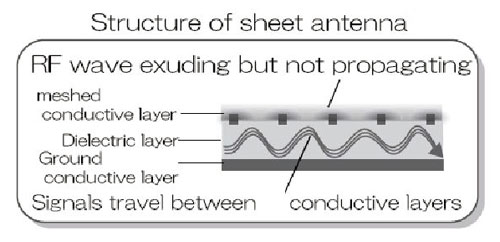Japanese company Teijin Fibers, employing technology from Hong Kong RFID firm Convergence Systems Ltd. (CSL) and Cellcross Co. Ltd., is marketing a new shelf-management system consisting of an RFID sheet antenna that can be placed on a shelf in order to track RFID tags on items placed on that shelf. The solution, which Teijin Fibers plans to officially launch this month in Japan, includes an EPC Gen 2 ultrahigh-frequency (UHF) CS468 RFID reader and a CS790 antenna designed and built by CSL, with a Cellcross-designed sheet antenna embedded in Teijin’s polyester fibers.
The sheet antenna limits the range of RF waves to better control the RF field, thereby reducing the amount of “bleed over” of RF transmission beyond the shelf’s edges, as well as the range at which it reads tags. The antenna is very thin—approximately 6 millimeters (0.2 inch) in thickness. Teijin’s solution also comes with the company’s software for storing and interpreting read data, in addition to CSL’s EPC Gen 2 UHF passive RFID tags. Teijin expects to launch the system commercially in Japan on Dec. 19.
Teijin’s Cell Form sheet antenna employs @CELL technology, developed a decade ago by Cellcross—an incubator company founded in 2002 by researchers at the University of Tokyo that includes Teijin Fibers as an equity partner. The @CELL RFID system is based on research carried out by Hiroyuki Shinoda, an associate professor at the University of Tokyo and a Cellcross cofounder, and is designed to enable the use a RFID technology at a very short range, with a flat, ultra-thin reader antenna placed on a shelf on which tagged goods will be stacked.
The antenna is designed to limit the RF signals within the “two-dimensional” sheet, comprising a bottom layer of conductive material and a top sheet of conductive mesh material, with a dielectric layer sandwiched between them. When a reader’s signal enters the bottom sheet, that signal passes upward through the dielectric and mesh layers, creating what Cellcross terms an “evanescent wave” that does not propagate, as a typical UHF signal would do. Instead, the RF signal seeps through gaps in the mesh, which is designed to allow that energy leakage and thereby create a highly localized RF field. The intention, the company explains, is to reduce the risk of security breaches that might result from transmissions that are less controlled (for example, extended far beyond the shelf), and to control the read range so that a tag’s removal from the shelf would be detected even if that tag were not moved far from the shelf.
Teijin Fibers’ current focus market for the technology is libraries, the company reports, with several pilots currently underway at an unnamed university library and an educational resource center, at which books are tagged and CSL’s CS790 sheet antennas (powered by CSL’s CS468 interrogators) are installed on shelves to identify where books are located, based on each tag’s unique ID number. When a tagged book is removed from a shelf, Teijin software updates that book’s status, indicating that the tag is no longer detected, and that the book has thus been removed from the shelf. Teijin’s shelf-management system includes up to eight Cell Form sheet antennas, a CSL read/write software module and 400 EPC Gen 2 RFID tags.
Several years ago, Convergence Systems Ltd. began working with Cellcross to incorporate the @Cell RFID sheet antenna into CSL’s product line (see CSL Unveils Ultra-Thin RFID Antenna Development Kit for Shelving Applications). Since June of this year, the company has been selling a solution worldwide using the same sheet antenna and a reader utilized in Teijin’s version. However, says Jerry Garrett, CSL’s managing director, the firm employs software from a variety of providers, depending on an end user’s location and needs.
According to Garrett, CSL’s CS790 series sheet antenna differs from all other UHF antennas presently on the market due to its ultra-thin form factor, variable length (the antenna can be provided in a variety of sizes to suit different types of shelves) and an “almost rectangular read zone on top of the antenna,” meaning that a tag that must be placed directly above the antenna in order for it to be read. “These three characteristics, combined together, make this antenna extremely adaptable to common open-shelf environments,” he states, “as well as cabinets and drawers.”
The CS790 antenna has a fixed width of 9.8 inches, and is available in three standard lengths: 14 inches, 27.6 inches and 39 inches. Its length can be cut to fit whatever dimensions are required, however, providing the ability to easily retrofit the antenna into existing environments. The antenna is available with a metal backing for use on non-metal surfaces, or with a plastic backing for use on metal.
The antenna can read tags at a distance of up to 1 meter away (3.3 feet). If it is optimized for ultra-densely packed items—such as multiple books stacked on a shelf, as might be seen within a library—that range can be narrowed to around 15 centimeters (5.9 inches). By reducing the reader’s output power, Garrett says, a user can further reduce the read range to 1 centimeter (0.4 inch).
In Convergence Systems Ltd.’s case, the CS790 series sheet antenna is designed for retail use, including in display cases and cabinets, as well as on desktops and shelves. CSL’s customers have pilots underway worldwide for its own version of the solution, Garrett says, consisting of the CS790 antenna, a CS468 reader and third-party software for managing read data. The solution is currently being tested by one furniture manufacturer that may build the technology into its products for use by that company’s business customers, as well as a jewelry store and other retailers. Approximately two dozen pilots are now underway, he estimates. CSL’s hardware costs approximately $5,000 for a single CS468 interrogator and 16 CS790 antennas.


